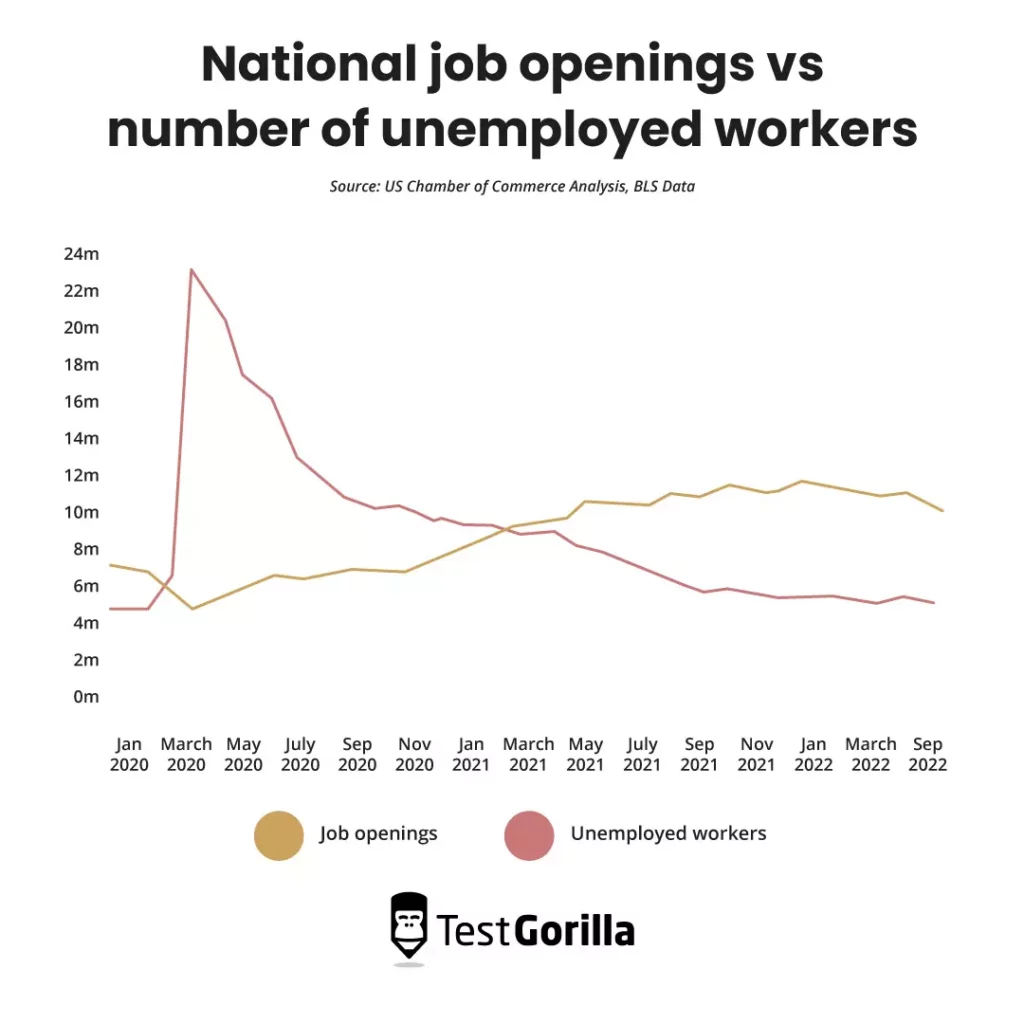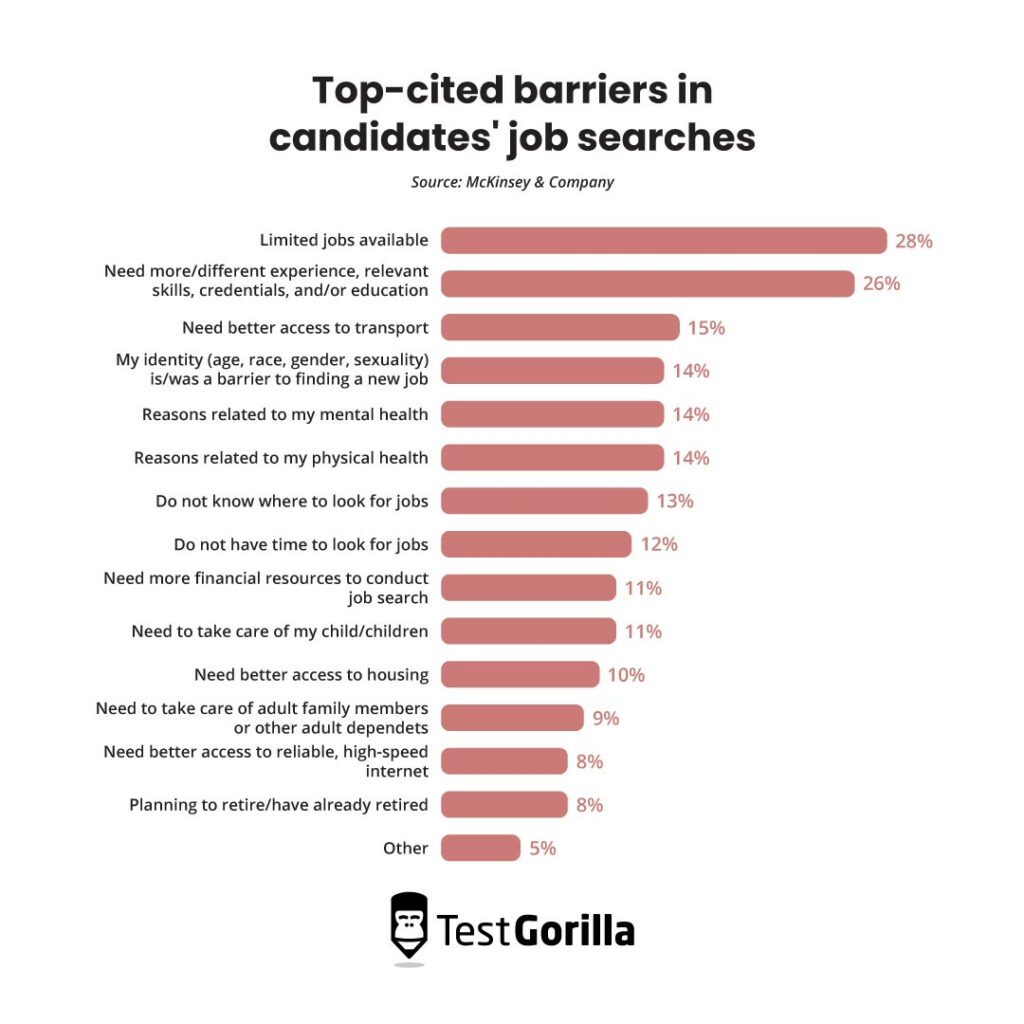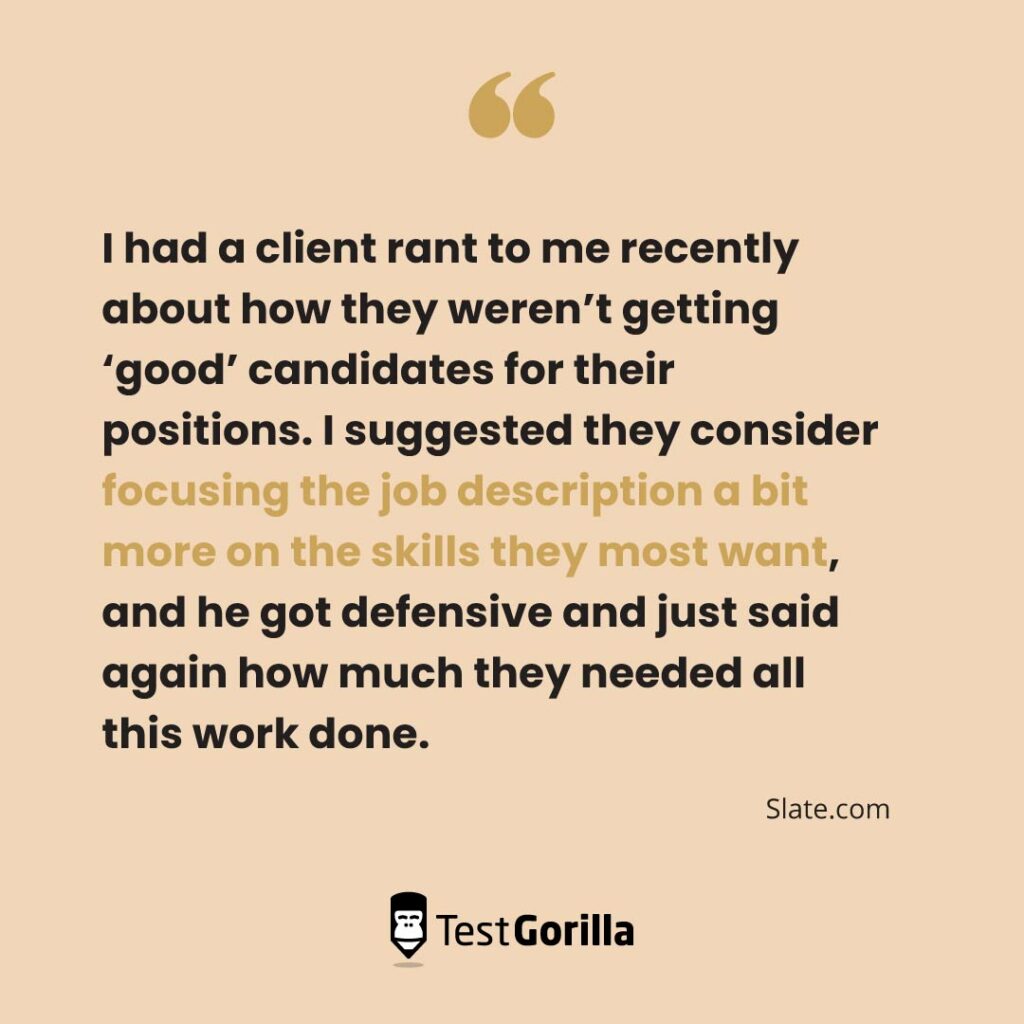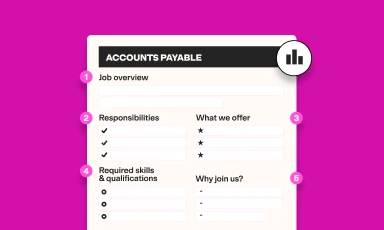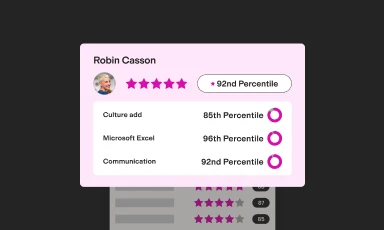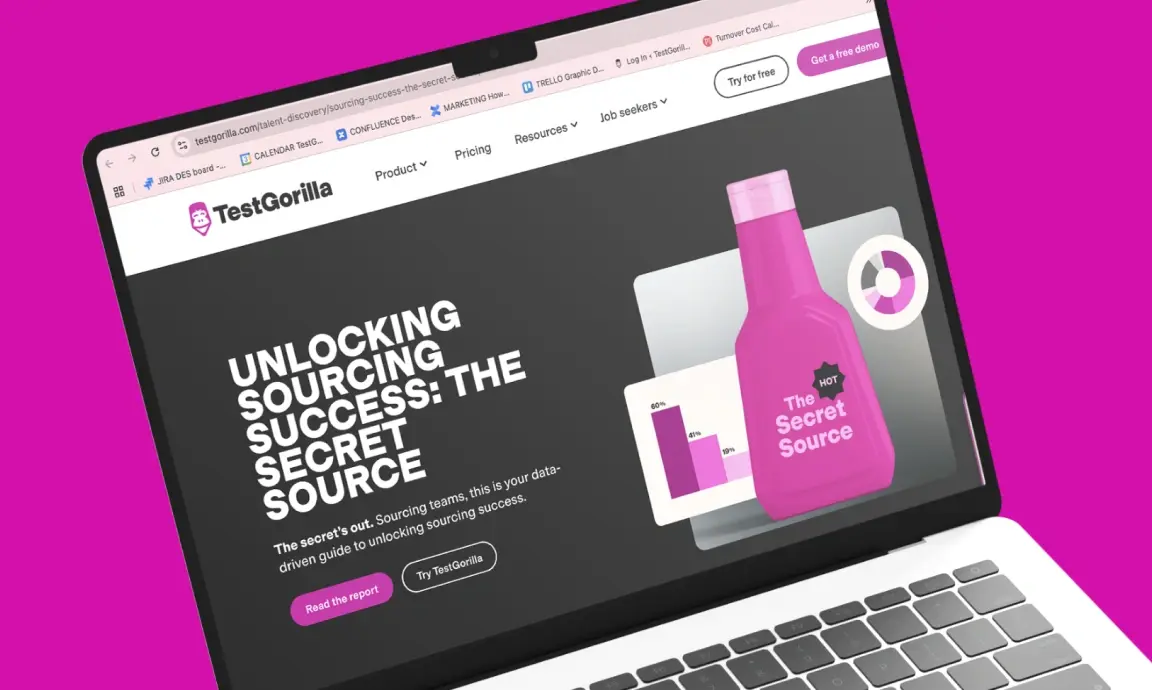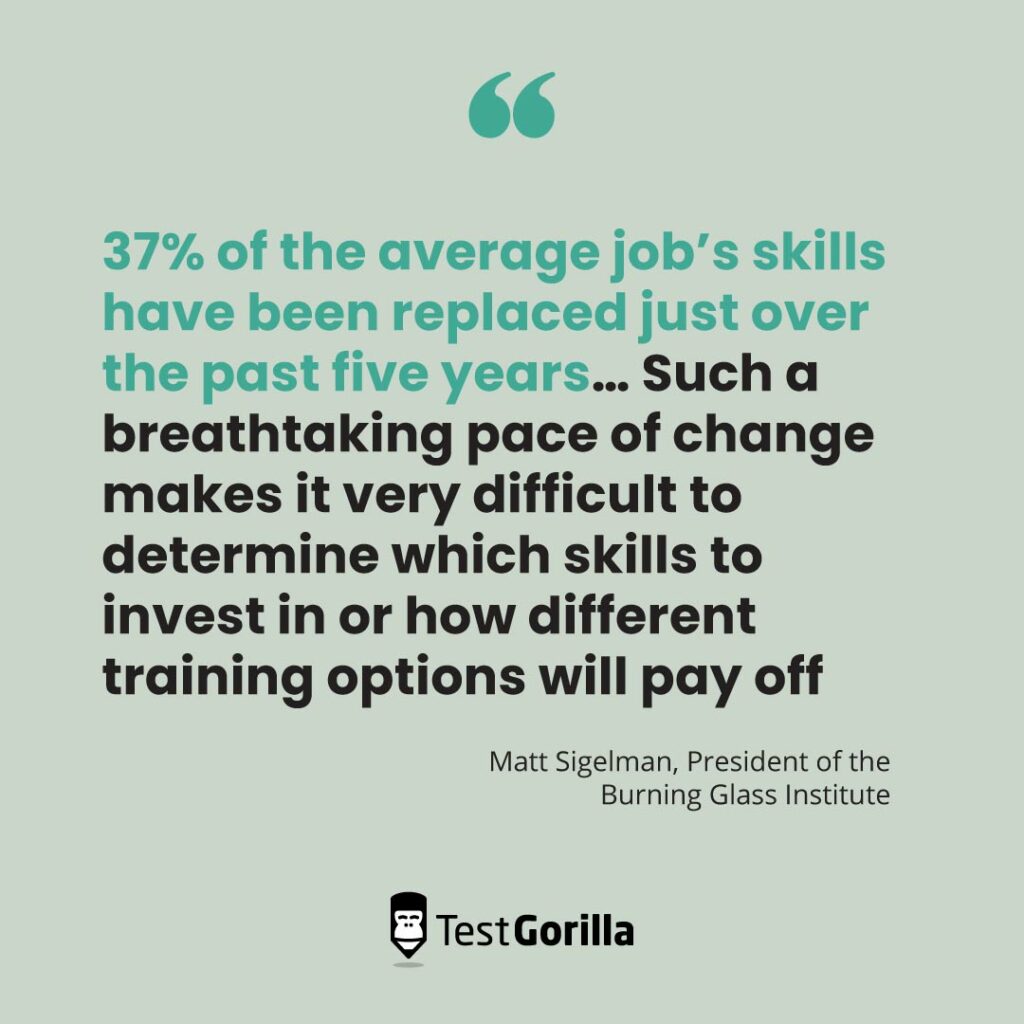The world of work can be uncertain at the best of times, but the turbulence of the past few years has made it that much harder to predict where it’s headed.
As companies grapple with the impact of talent shortages, rapid technological advances, and economic upheaval, they’re taking a closer look at the systems and processes that drive their recruitment to find the best path through the storm.
Unfortunately, their newfound insights haven’t yet filtered down to the ground level. Recent data shows that 57% of chief executives still struggle to attract qualified workers despite a 3 million increase in open positions versus pre-pandemic levels.
To adequately address these challenges, hiring managers must question their beliefs about the job market, such as
Does automation spell the end of work as we know it?
Is compensation the critical factor that causes employees to switch jobs?
Are companies operating in a candidate-driven market?
In this blog post, we’ll investigate some of these hiring myths and see whether they hold up under scrutiny.
Table of contents
- Hiring myth #1: The best candidates aren’t active in the job market
- Hiring myth #2: Compensation is the primary motivator for candidates
- Hiring myth #3: The current job market favors candidates
- Hiring myth #4: Automation could spell the end of employment as we know it
- The right tools will make it easier to navigate the job market of the future
Hiring myth #1: The best candidates aren’t active in the job market
On the surface, this myth makes a lot of sense.
An estimated 37% of candidates are classified as passive, i.e., employed individuals who aren’t actively looking for work. The remaining 63%, who are actively looking for jobs, are classified as active. Active candidates can be employed or unemployed.
The thinking goes that passive prospects are more likely to be successful hires because they’re more discerning about the opportunities they take and, therefore, less willing to embellish their resumes to target a specific job.
Many employers see these candidates as “proven quantities” who have demonstrated their ability to create value for an organization. The fact that they’re currently working also puts to bed any speculation that would otherwise surround an applicant who was fired or laid off from their previous job.
This bias presents strongly in most companies’ recruitment funnels. Surveys reveal that 70% of hiring managers believe unemployed candidates make less productive employees.
Research from the University of California, Los Angeles (UCLA), backs up these findings. According to the paper’s co-author Geoffery Ho, “unemployed applicants are viewed as less competent, warm, and hirable than employed individuals.” More importantly, the study confirms that this bias persists regardless of whether they were let go from their last job or left voluntarily.
The verdict: False
The truth is passive candidates are no more skilled or motivated than active job seekers.
In a 2020 report from Indeed, 70% of professionals said active candidates were typically more successful once hired. Meanwhile, the most commonly cited reason for passive candidates failing was a lack of enthusiasm for their new role.
Considering the factors that drive active prospects, this data should come as no surprise.
These individuals are taking proactive steps to find jobs that align with their career vision. Sure, they might have applied for other open positions, but they’ve also looked at the market and decided that your company suits their skillset well.
There’s also something to be said about the mindset of an active candidate. They are confident in their abilities and are willing to go through an (often stressful) hiring process to prove their value as an employee. As a result, they’re more responsive throughout the recruitment cycle and more likely to accept offers when they arrive.
Meanwhile, passive candidates will generally have to be courted and sold on the role before they express a clear interest, which increases their time-to-hire. Because they’re approached directly, they also have higher salary expectations. The study mentioned above shows that up to 57% of these applicants expect a salary increase of 15% or higher on their last job.
The most significant proportion of active jobseekers are in the coveted 18-34 age range and tend to be better educated than their peers. Many of these candidates are fresh graduates looking to get their careers off the ground, which explains why they’re more enthusiastic about the companies they choose to work for.
Hiring myth #2: Compensation is the primary motivator for candidates
The cost-of-living crisis has been a hot topic in any conversation about hiring and for good reason.
Inflation has outstripped real wage growth for the past few years, causing a massive spike in the price of, well, pretty much everything from gas and food to housing and medical care.
These issues haven’t gone unnoticed in corporate boardrooms. According to research from Lancaster University and the Work Foundation, two-thirds of senior executives agree that they must support their employees through this crisis.
Add to this an extremely competitive labor market in which companies from all industries are engaged in a war for highly skilled talent, and you have the perfect recipe for rising compensation.
Pay transparency laws are another key driver here. As of June 2023, eight states have rolled out regulations that mandate employers disclose salary ranges for advertised roles. By the end of the year, up to 25% of workers are expected to be covered under the new rules.
Of course, these requirements are pushing employers to get serious about how they manage communications around compensation.
In line with these trends, 57% of employers plan to increase advertised pay for open positions, and a further 44% are factoring in signing bonuses for new hires.
But is pay really the deciding factor for candidates? Or is there more to the story?
The verdict: True (with some caveats)
Compensation could be the primary reason job seekers choose one employer over another.
According to Gallup surveys, pay has gone from number four on the list of candidate priorities in 2015 to number one in 2023. But that’s not to say it’s the sole motivator.
In the post-pandemic era, flexible work arrangements have become a core priority for job seekers, and many expect to be given some measure of independence over when and where they work. In fact, Gen Z candidates actually rank work-life balance as the primary determinant of whether they accept or reject an offer.
The desire for remote work can be a game changer for employers here. A report from the tail-end of 2022 showed that 56% of employees would be tempted to switch jobs if remote working options were offered.
Earlier, we mentioned how passive and active candidates see the hiring process differently. These distinctions also extend to their motivators in the job market. For the latter, the possibilities for career advancement and skills development provided by a new role were more critical factors than compensation.
This tendency forms part of a larger conversation around the desire for purpose in the workplace. At a time when companies are scrambling to retain their best talent, it’s not enough to simply offer candidates enough money to switch roles; employers must give them a reason to care about what they do as well.
The best insights on HR and recruitment, delivered to your inbox.
Biweekly updates. No spam. Unsubscribe any time.
Hiring myth #3: The current job market favors candidates
As the world began to open up at the end of 2021, the number of open positions skyrocketed to 12 million, and at the same quit rates hit an all-time high in what soon became known as the “Great Resignation.” The result was a historically tight labor market.
Those trends have shown no signs of slowing down. Despite the widespread tech layoffs led by industry heavy hitters like Meta and Amazon, the US economy added 339,000 jobs in May 2023, almost double the projected job openings for the month.
Inescapable demographic shifts are a major contributor to these unemployment numbers.
There was a virtually uninterrupted supply of new labor to the job market between the 1970s and the 2000s, thanks to baby boomers and millennials. However, people from the former age group are now hitting retirement age, and subsequent generations aren’t entering the workforce in sufficient numbers to replace them. Immigration levels have also dropped recently, further deepening the talent shortage.
These factors have led many experts to dub this a candidate-centric job market. One where job seekers have the power to be more selective about the employment opportunities they choose and demand more from employers in terms of compensation and benefits.
The verdict: It’s complicated
Although talent acquisition and retention are at the forefront of executives’ minds, there’s still a sense that most employers are only willing to hire on their terms.
In a survey conducted by Mckinsey last year, 28% of respondents said that their most significant barrier to employment was the limited availability of jobs. A further 26% said they needed more experience, relevant skills, or credentials to get hired.
These statistics tell a tale of two distinct labor markets.
The first comprises high-demand candidates with college educations and significant industry experience. These individuals can set their terms on the market and often have their pick of opportunities.
The second comprises workers without the same qualifications and relevant work history, often stuck in low-wage roles. Although positions are available for job seekers in the food, retail, and accommodation industries, the opportunities are often underpaid and labor-intensive.
As for more coveted roles, many companies still set strict degree and experience requirements for vacancies, even though these factors have a negligible impact on job performance. In the process, they severely limit their pool of applicants leaving many talented candidates out in the cold.
A broader issue shaking candidates’ confidence in the job market is the possible threat of a recession. While indicators are still holding firm, 57% of C-suite executives admit that they are planning to let employees go this year in an effort to manage costs and maintain agility. Interestingly, a large portion of these organizations are also increasing their hiring budgets for the year, albeit with a far more focused approach to talent acquisition.
Hiring myth #4: Automation could spell the end of employment as we know it
For years, economists have talked about how rising automation will affect employment across several industries.
According to Adrian Cooper, Chief Economist at Oxford Economics, “existing business models across many sectors will be seriously disrupted. And tens of millions of existing jobs will be lost [as a result of AI],” with entry-level and low-skilled workers bearing the brunt of the impact.
Further research shows that these effects could be split along racial lines, with African American and LatinX communities overrepresented in the list of occupations predicted to become obsolete over the next decade. World Economic Forum estimates show that up to 75 million jobs may already have been lost to automation.
If these emerging issues aren’t corrected proactively, we can expect income inequality to become even more pronounced. Particularly when career paths in labor-intensive fields such as construction, transportation, and warehousing or service-oriented industries, including customer support and food services, are slowly phased out.
With the recent rise of generative AI tools such as ChatGPT, a range of knowledge-intensive professions, such as software development, content marketing, and even medicine, could soon be threatened as well.
The verdict: True (but there’s reason to be optimistic)
Many industry experts see clear opportunities within this reshaped world of work. For example, when automation enabled manufacturers to produce goods in unprecedented volumes, the increase in production created opportunities for logistics providers to set up networks to deliver these outputs throughout the globe.
In this case, we’re seeing an increased demand for technical professionals with the skills to build, monitor, and optimize AI solutions, but these competencies are currently in short supply.
Traditionally, employers have relied on universities to produce candidates with the necessary knowledge and expertise to fill these gaps. However, in the modern workplace, where skills become outdated at an unprecedented rate, four-year degree programs fail to address these deficiencies.
As a result, employers are beginning to accept that current employees must be enabled to acquire new skills (upskill) and update their existing competencies (reskill). A crucial part of this effort is understanding the current state of expertise within different teams and the additional skills required to meet short, medium, and long-term objectives.
This cannot be a one-size-fits-all initiative. As the number of critical roles across the organization grows, leadership teams must invest in programs that provide individuals with the right combination of knowledge and practical skills.
The training must be accessible to all team members and aligned with their work schedules. Videos, self-learning courses, and applications are excellent tools for driving these upskilling and reskilling efforts.
It’s important to acknowledge that a considerable part of your workforce won’t be able or willing to transition into a technical role. Instead, these individuals must find new ways to differentiate themselves in a world where machines can wholly or partially take over highly technical tasks.
The right tools will make it easier to navigate the job market of the future
The job market might be hard to predict, but if you can take steps to futureproof your organization’s hiring process today, then it will be well-placed to handle any challenges that arise in the years to come.
Skills-based hiring is the best tool for driving this transformation.
By shifting the focus of your recruitment away from inaccurate and biased resume-based screening and moving to a skills-based evaluation system, you can hire talent with the cognitive ability, technical competency, and soft skills to lead your company into this new world of work.
Ready to start building a skills-first organization? Check out our blog post on how to implement these practices here. If you’re still unsure about the wider benefits of skills-based hiring, read our comprehensive report on the topic here.
You've scrolled this far
Why not try TestGorilla for free, and see what happens when you put skills first.


